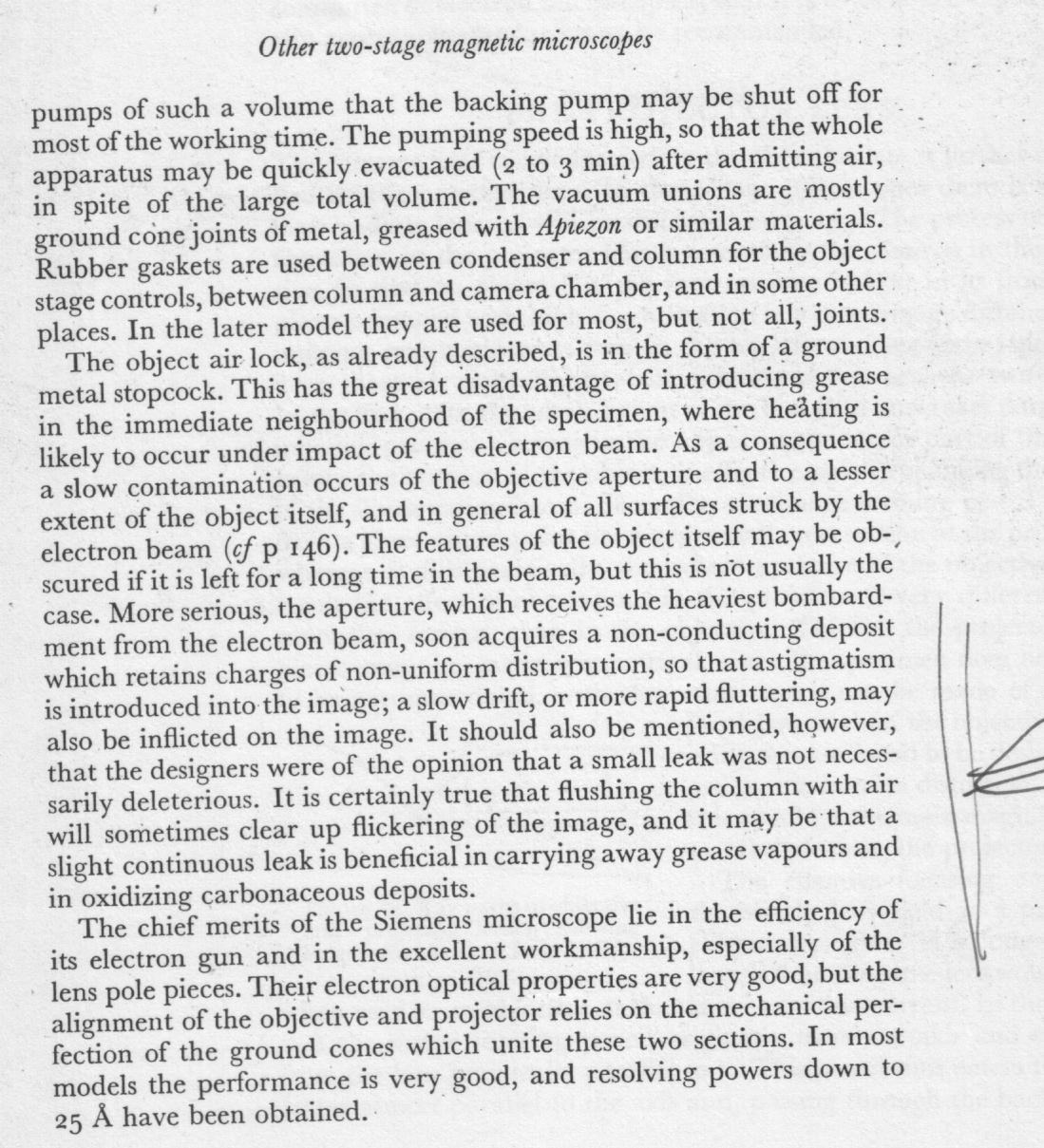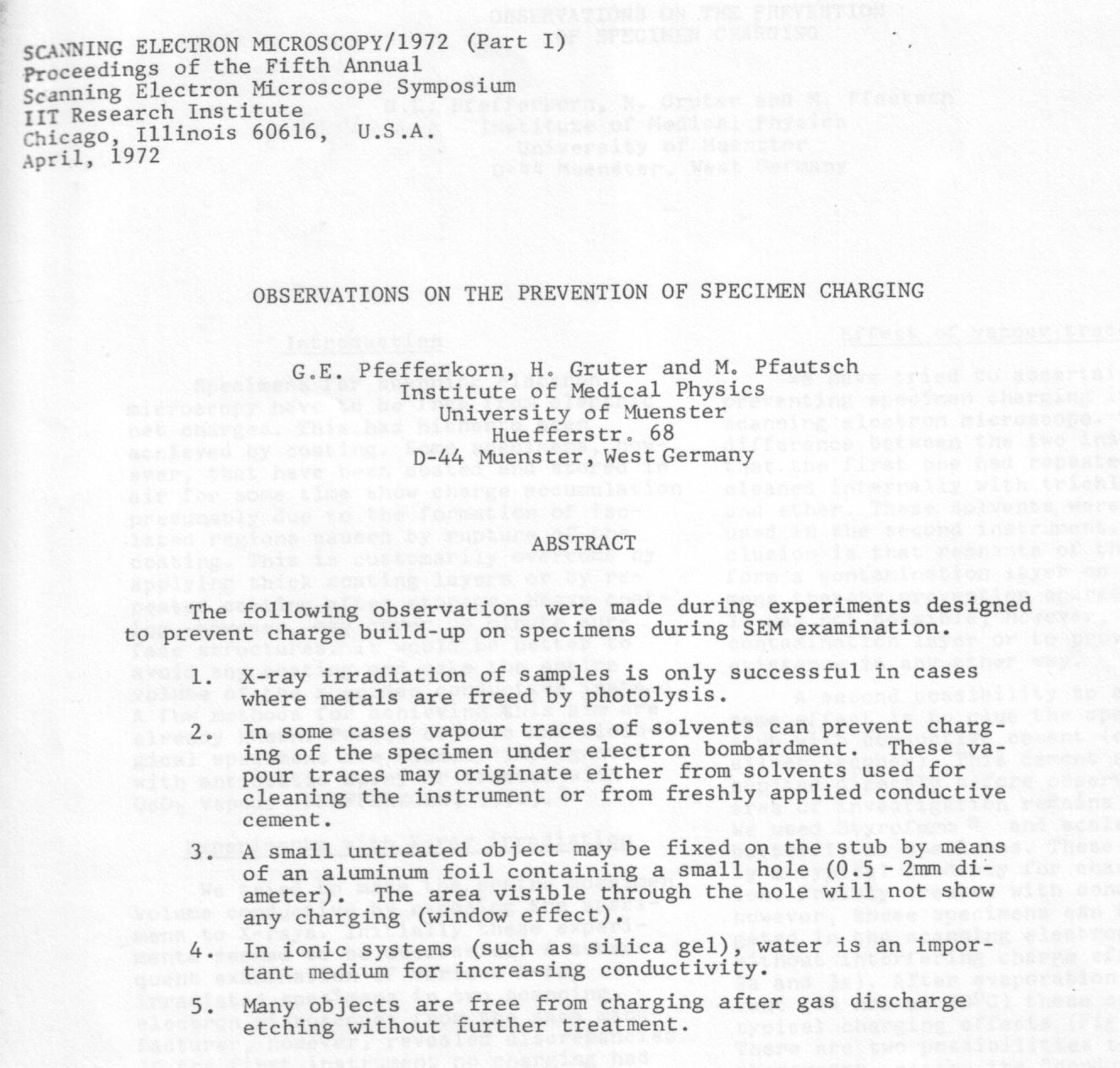
According to the following early commercial brochure, ECM stands for Environmental Cell Modification, Environmental Cell Module, Environmental Control Module, Environmental Control Mode, Exceptionally Clever Microscopy, or Elimination of Charging Mode.

Perhaps the second last choice for the acronym is the most universal one that may encompass all, regardless of history or circumstances. As it happened with the Robinson detector , the elimination of charging, if ECM means just that, by use of a gaseous environment is a relatively old concept in electron microscopy: In the "use of gas microcells in electron microscopy ", Stoyanova (1961) reported in no uncertain terms the operation of a closed environmental cell; virtually nil charge accumulation was observed on insulating specimens as soon as the gas pressure was 1 torr. Otherwise (in vacuum), field emission due to specimen charging could result in specimen damage:

The role of gas for charging elimination was well known and generally taken for granted in environmental scanning transmission electron microscopy, e.g. see below excerpt from Parsons et al. (1974):

Cosslett (1951) has also reported the beneficial effect of a gaseous leak in the column:

Even at the same Meetings (IITRI), where Robinson presented his work, we find Pfefferkorn (1972) discussing the presence of vapors as one possible explanation for the observed charge elimination on insulating specimens:

By virtue of the above quoted references, the idea of using gas up to 1 torr as means for charge elimination in the SEM clearly predates the promotion of ECM. However, Robinson must be credited for commercializing this concept as a companion to his BSE detector . Robinson (1974) must be further credited for approaching, momentarily, near 4.6 torr of water vapor. An image could be literally fluked quickly before the microscope operation was interrupted due to gas leaking in the electron gun chamber. Thus, the ECM+Robinson's detector had not been sufficient or tantamount to high pressure SEM routine work. Many problems and hurdles had to be overcome with a new understanding, before a fully fledged ESEM could be claimed. However, Robinson has contributed in the chain of developments along with other investigators, starting with a large number of workers in environmental transmission electron microscopy, then in environmental SEM with Cowley (1970), Lane (1970), Spivak (1977) and Shah (1979). Thereafter, a fully fledged ESEM including both backscattered and secondary electron detection capabilities was developed and became a viable commercial venture based mainly on the works contributed by Danilatos . The science of ESEM is represented by the published works of all investigators involved, which must be set apart from the commercial developments.
IMPORTANT: It should be noted that ECM was never commercialized to operate at any pressure higher than 1 torr. The same system was soon renamed and marketed by just another acronym: "The ISI Robinson Charge Free Anticontamination System (CFAS)". The mention of "high" pressure in ECM actually means low pressure, clearly less or much less than 1 torr. The ECM is an attachment to control the dose of a very small amount of gas inside the specimen chamber of unmodified SEMs that continue to operate normally. As soon as the pressure exceeds this limit, the normal SEM operation breaks down. Therefore, the ECM should not be confused with the ESEM developments that followed by Danilatos. The large number of ECM units claimed to have been sold with the "ISI-SEMRA-WET-SEM" equipment has no nexus with the examination of really wet specimens or with ESEM.
Conclusion: ECM has been commercially promoted by Robinson, whilst ESEM has been scientifically pioneered and promoted by Danilatos to the commercial stage by ElectroScan Corporation.
References
Stoyanova IG (1961) Use of gas microcells in electron microscopy. Akademiya Nauk SSSR, Izvestiya, Ser. Fizicheskaya 25 (715-721). In English.
Parsons , D.F., Matricardi, V.R., Moretz, R.C., and Turner, J.N. (1974) Electron microscopy and diffraction of wet unstained and unfixed biological objects. Adv. Biol. Med. Phys. 15:161-271.
Cosslett VE (1951). Practical Electron Microscopy. Butterworths Scientific Publications, London, p.59.
Pfefferkorn CE, Gruter H and Pfautsch M (1972). Observations on the prevention of specimen charging. Scanning Electron Microscopy, IIT Research Institute, Chicago, Illinois, USA, 147-152.
Robinson, V.N.E. (1974) A wet stage modification to a scanning electron microscope. 8th Int. Congr. El. Microsc., Australian Academy of Science, Vol II:50-51.
Cowley JM, Smith DJ and Sussex GA (1970). Application of a high-voltage transmission scanning electron microscope. Scanning Electron Microscopy, IIT Research Institute, Chicago, Illinois, USA, 9-16.
Lane, W.C. (1970) The environmental control stage. Scanning Electron Microsc.: 43-48.
Spivak, G.V., Rau, E.I., Karelin, N.M., Mishustina, I.E. (1977) Scanning electron microscopy of moist, live, and frozen objects. Izv. Akad. Nauk SSSR, Ser. Fiz. 41, 11:2238-2251 (Russian).
Shah, J.S., and Beckett, A. (1979) A preliminary evaluation of moist environment ambient temperature scanning electron microscopy. Micron 10:13-23.